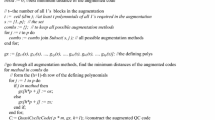Abstract
Previous results have shown that the class of quasi-cyclic (QC) codes contains many good codes. In this paper, new rate (m - 1)/pm QC codes over GF(3) and GF(4) are presented. These codes have been constructed using integer linear programming and a heuristic combinatorial optimization algorithm based on a greedy local search. Most of these codes attain the maximum possible minimum distance for any linear code with the same parameters, i.e., they are optimal, and 58 improve the maximum known distances. The generator polynomials for these 58 codes are tabulated, and the minimum distances of rate (m - 1)/pm QC codes are given.
Similar content being viewed by others
References
E. H. L. Aarts and P J. M. van Laarhoven, Local search in coding theory, Discrete Math.,Vol. 106/107 (1992) pp. 11 18
A. E. Brouwer, Table of minimum-distance bounds for linear codes over GF(3) and GF(4), lincodbd server, aeb@cwi.nl, Eindhoven University of Technology, Eindhoven, the Netherlands (1993)
R. N. Daskalov, R. Hill and P. Lizak, Tables of bounds on linear codes over GF(3) and GF(4), Technical University, Gamrovo, Bulgaria (1992)
H. Fredricksen and J. Maiorana, Necklaces of beads in k colors and k-ary de Bruijn sequences, Discrete Math.,Vol. 23(1978) pp.207–210
R. G. Gallager, The random coding bound is tight forthe average code, IEEE Trans. Inf TheoryVol. IT 19 (1973) pp. 244–246
P. P. Greenough and R. Hill, Optimal ternary quasi cyclic codes, Designs, Codes and CryptographyVol. 2 (1992) pp. 81 91
T A. Gulliver and V. K. Bhargava, Some best rate I/p and rate (p-1 )/p systcmntic quasi cyclic codcs, IEEE Trans. Inf TheoryVol. IT-37 (1991) pp. 552–555
T. A. Gulliver and V K. Bhargava, Some best rate I/p and rate (p-1)/p systematic quasi-cyclic codes over GF(3) and GF(4), IEEE Trans.I nf Theory Vol. IT 38 (1992) pp. 1369 1374
T. A. Gullver and V. K. Bargava, Nine good rate (m-1)/pm quasi-cyclic codes, IEEE Trans. Inf heory Vol, IT-38 (1992) pp. 1366–1369
T. A. Gulliver and V K, Bhargava, V.K. Twelve good rate (m-r)/pm quasi cyclic codes, IEEE Trans. Inf TheoryVol. IT-39 (1993)
M. Hall, Jr., Combinatorial Theory Blaisdell Publishing Co., Waltham, MA (1967)
A A. Hashim and A.G. Constantinides, Some new results on binary linearblock codes, Electronics Letters Vol. 10(1974) pp. 31 33
A A Hashim and V S Podniakov, Computerized search for linear binary codes, Electronics Letters Vol. 12(1976) pp. 350–351
T. Kasami, A Gilbert-Varshamov bound forquasi-cyclic codes of rate 1/2, IEEE Trans. Inf Theory Vol. IT-20 (1974) pp. 679
F.R. Kscdicllalg and S. Pusupathy, tome ternary and quaternary codes and associated sphere packings, IEEE Trans. Inf Theory.Vol. IT-38 (1992) pp. 227–246
F.J. MacWilliams and N.J. A. Sloane, The Theory of Error-Correcting Codes North-Holland Publishing Co., New York (1977)
J. N. Pierce, Limit distribution of the minimum distance of random linear codes, IEEE Trans. Inf Theory Vol. IT-13 (1967) pp. 595–599
G. E. Seguin and G. Drolet, The Theory of I Generator Quasi-Cyclic Codes Royal Military College of Canada. Kingston. ON (1991
N. J. A. Sloane, Tables of lower bounds on dmax(n,k) for linear codes over fields of order 3 and 4. to appear in V. Pless, et al., The Handbook of Coding Theory.
G. Solomon and J. J. Stiffler, Algebraically punctured cyclic codes, Inf and Conir Vol. 8(1965) pp. 170–179
H. C. A. van Tilborg, On quasi cyclic codes with rate 1/m.IEEE Trans. Inf Theory Vol. IT-24 (1978) pp. 628 629
Author information
Authors and Affiliations
Rights and permissions
About this article
Cite this article
Gulliver, T.A., Bhargava, V.K. New Good Rate (m-1)/pm Ternary and Quaternary Quasi-Cyclic Codes. Designs, Codes and Cryptography 7, 223–233 (1996). https://doi.org/10.1023/A:1018090707115
Issue Date:
DOI: https://doi.org/10.1023/A:1018090707115




